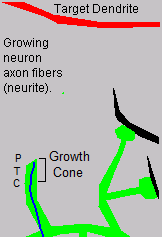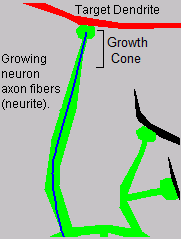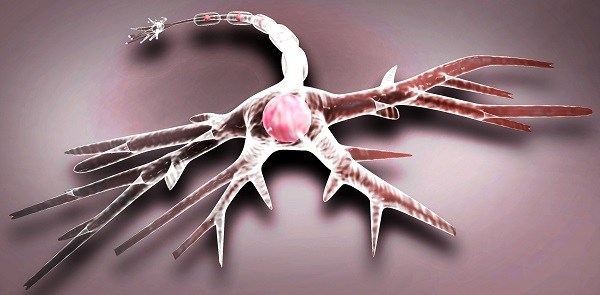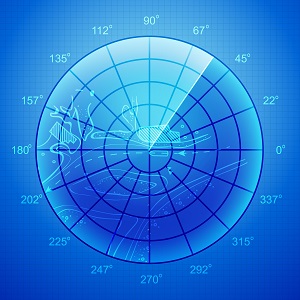01 Jan Axon and Dendrite Growth
Link Formation in a Bio-Network
 It was once believed that the link structure of the nervous system was formed randomly during embryogenesis and remained static after maturation – sometime between early development and adolescence (except for regeneration after injury). Due to improved imaging resolutions and preparation techniques, we now know that axon termini, dendrites, and spines form throughout our lifetime. We also know they can be retracted as well as extended. If nerve fibers stopped forming early in life, link formation would not be critical to learning. Typical artificial neural networks model learning by adjusting the weights (usually through backpropagation) of existing links instead of forming new ones.
It was once believed that the link structure of the nervous system was formed randomly during embryogenesis and remained static after maturation – sometime between early development and adolescence (except for regeneration after injury). Due to improved imaging resolutions and preparation techniques, we now know that axon termini, dendrites, and spines form throughout our lifetime. We also know they can be retracted as well as extended. If nerve fibers stopped forming early in life, link formation would not be critical to learning. Typical artificial neural networks model learning by adjusting the weights (usually through backpropagation) of existing links instead of forming new ones.
A neuromorphic model for computation that accounts for the brain’s ability to form new – and retract existing – physical links would be a dynamic network capable of adapting or learning by forming new links. This differs profoundly from typical artificial neural networks whose link structure is static before learning begins. In those networks, only the weights change as a result of learning. It may, however, be possible to logically simulate link formation with a physically static net.
The physiology of the brain can support learning by…
- forming new links with nearby neurons;
- using relay cells to form links with remote cells;
- adjusting the weights of existing links (synapses); and
- activating inactive links.
A long-term memory model should reflect the ability of our brains to form new links throughout our lifetime.
| Understanding Context Cross-Reference |
|---|
| Click on these Links to other posts and glossary/bibliography references |
|
|
|
| Prior Post | Next Post |
| Signal Transduction in Neurons | Synapse Formation |
| Definitions | References |
| nerve fibers | Cooper 1985 Jnl of Neuroscience |
| axon dendrites | Trinkaus 1985 |
| backpropagation | SRI Speech Site |
| filopodia | Let it Out Baby Nature |
 Nerve Process Growth
Nerve Process Growth
Internal and external factors govern the sprouting and growth of neurites. Internal factors that limit the extension of neurites are primarily associated with the time required to build the cytoskeleton (blue line in the illustration) of the new appendage. The main internal process in neurite cytoskeletal formation is polymerization. As quickly as organelles such as ER can synthesize dimers and oligomers for IF and MT, the filaments grow or extend and push the elastic membranes outward. Because of the twisting and bending capabilities of microtubules, the direction of neurite growth, or its navigation, can be assisted by the internal mechanisms of the MAPs dynein and kinesin.
The central role of cytoskeletal filaments and MT in determining nerve fiber morphology indirectly affects the processing of all electrical impulses handled by neurons. This suggests that the roles of the cytoskeleton in cybernetic or cognitive functions cannot be discounted; in fact, they should be researched further to see if their transductance abilities are used to fill the role of “wires” in neural circuitry.
The illustrations at right (originally part of an Asymetrix TBK animation) show in red a Target Dendrite, in green a Growing axon fiber (neurite), and in black Existing Synapses.
 Axon and Dendrite Growth Rates
Axon and Dendrite Growth Rates
The biochemically limited growth rate of neurites corresponds to the rate of axoplasmic transport – roughly 100 microns per hour. Two to four millimeters per day may seem rather slow (one to two mm/day in adults) until you consider these facts:
- the navigational space is already crowded with the dense, intertwining arborization of other neurons;
- the distance necessary for establishing new links may frequently be less than a millimeter; and
- spines are so short (10-20 microns) that a new spine and synapse may form within 20 minutes.
This amazing rate of growth lends credibility to a learning theory which includes the premise that the formation of new links between neurons actually represents concepts. The precision of neurite navigation suggests less randomness or chaos and more organization in the structure of the neural matrix.
Growth Cone
The tips of growing neurites are called growth cones. These growth cones provide the extending appendage with the ability to steer. Filopodia are the growth-cone features that appear to be most active in guiding the neurite through the neural matrix to target synaptic links. Filopodia act like feelers; they respond to physical obstacles, chemical signals, and possibly even electrical signals to guide the growth cone. The physical obstacles that filopodia must discover and circumnavigate are glial cells, other neurons, and nerve fibers.

The growth cone is divided into in three zones based on function. The Central or C-domain is the MT polymerization site. After the MTs’ dimers are formed into protofilaments, then joined in tubes, they are stabilized in the axon shaft. The Transition or T-zone limits MTs penetration in the C-domain through a barrier of high density actin filaments meshwork. This is associated with myosin. The Peripheral or P-domain pushes the head of the growth cone. This domain is very dynamic, consisting mainly of actin in bundles in filopodia, and meshwork in lamellipodia. There are transient interactions between actin filaments and MTs in the P-domain, but their nature and impact is largely speculative. MTs and actin-associated proteins are responsible for polymerization, transport and stabilization.
 Steric guidance is one of the extrinsic processes contributing to neurite navigation. Chemotaxis provides a chemical guidance mechanism, and haptotaxis provides an adhesive substratum for growth-cone movement (Trinkaus, 1985, pp. 8-14). Galvanotaxis is the term for the process whereby electrical fields influence the navigation of growth cones. Although there is no concrete evidence that this process is active in neurite extension, plausible theories of galvanotaxis have been proposed and demonstrated in in-vitro tissue cultures (Cooper & Schliwa, 1985, pp.225-228).
Steric guidance is one of the extrinsic processes contributing to neurite navigation. Chemotaxis provides a chemical guidance mechanism, and haptotaxis provides an adhesive substratum for growth-cone movement (Trinkaus, 1985, pp. 8-14). Galvanotaxis is the term for the process whereby electrical fields influence the navigation of growth cones. Although there is no concrete evidence that this process is active in neurite extension, plausible theories of galvanotaxis have been proposed and demonstrated in in-vitro tissue cultures (Cooper & Schliwa, 1985, pp.225-228).
Aircraft commonly have radar guidance systems in their nose cones. Growing neurites have a guidance system, too. In fact, it appears that the sensor system in the neurite growth cone closely resembles the advanced technology aircraft with its suite of mutually supporting sensors with different capabilities. Filopodia act like the electromagnetic pulses sent out by active radar.
You may ask, what does the growth of neuron appendages have to do with cybernetics? In many or most scenarios, nothing. In learning systems, however, the fact and speed of new link formation, and the operative mechanisms, may guide us to more elegant solutions. I am determined to keep my radar active.
| Click below to look in each Understanding Context section |
|---|








